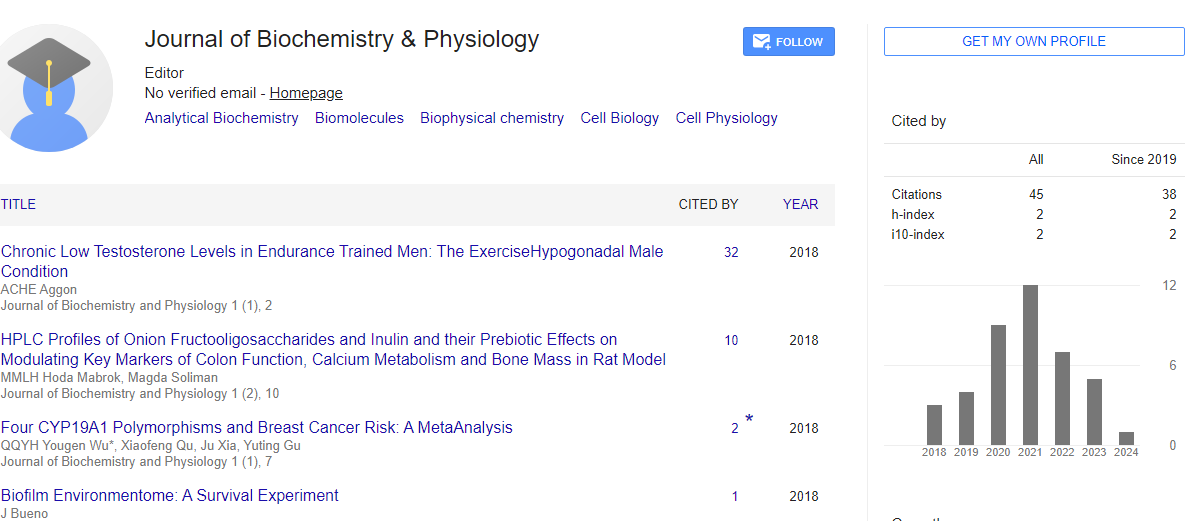Commentary, J Biochem Physiol Vol: 6 Issue: 2
Synthesis and Advantages of Multi-Metallic Proteins: Exploring the Structural Complexity and Functional Versatility
Edward Brice*
1Centre for Chemistry and Biotechnology, Deakin University, Geelong, Australia
*Corresponding Author: Edward Brice,
Centre for Chemistry and Biotechnology,
Deakin University, Geelong, Australia
E-mail: edwardbrice@daekin.edu.au
Received date: 29 May, 2023, Manuscript No. JBPY-23-110435
Editor assigned date: 31 May, 2023, PreQC No. JBPY-23-110435 (PQ);
Reviewed date: 14 June, 2023, QC No. JBPY-23-110435;
Revised date: 21 June, 2023, Manuscript No. JBPY-23-110435 (R);
Published date: 28 June, 2023 DOI: 10.4172/jbpy.1000131
Citation: Brice E (2023) Synthesis and Advantages of Multi-Metallic Proteins: Exploring the Structural Complexity and Functional Versatility. J Biochem Physiol 6:2.
Abstract
Multi metallic Nanoparticles (NPs) were created via nanotechnology employing nanoscale materials. Rich electrical, optical, and magnetic properties can be found in multi metallic NPs, especially those composed of more than two metals. When compared to monometallic and bimetallic nanoparticles, tri metallic NPs exhibit novel physicochemical features because of their synergistic or multifunctional effects for a variety of possible applications.
Description
Multi metallic Nanoparticles (NPs) were created via nanotechnology employing nanoscale materials. Rich electrical, optical, and magnetic properties can be found in multi metallic NPs, especially those composed of more than two metals. When compared to monometallic and bimetallic nanoparticles, tri metallic NPs exhibit novel physicochemical features because of their synergistic or multifunctional effects for a variety of possible applications.
Tri metallic Nanoparticles (NPs) are created from three different metals to reduce metal consumption, arrange the atoms, and fine-tune their size and appearance. To maximize the synergistic performance of multi metallic NPs, their structure, chemical makeup, and shape can be changed. Due to their resistance to numerous medications, bacterial infections are now a leading cause of illness and mortality worldwide. Initiatives to produce novel, alternative antibacterial materials have been sparked by this, and they address the problem of infection with multidrug-resistant bacteria
Proteins as models for intricate artificial metalloclusters. Nearly 50% of all proteins in nature contain metals. The most amazing chemical changes in nature are supported by multi-metal clusters that are buried in proteins. In general, multi metallic nanoparticles outperformed monometallic nanoparticles in terms of enzyme-like activity. Multi metallic NP-decorated MOFs can improve catalytic performance.
Synthesis
• Solvthermal/Hydrothermal Technique
• Correduction Technique
• Wire Explosion Electrical Cooperation
• Microwave Technique
• Sol-Gel Technique
Biological approaches
Investigating the underlying physics and prospective uses of alloy nanoparticles in areas like heterogeneous catalysis. It combines features of block copolymer lithography with scanning probe methods, enabling the controlled synthesis of nanoparticles with diameters ranging from 2 to 50 nm. SPBCL or scanning probe block copolymer lithography, is a novel technique for this method can be used to produce alloy nanoparticles made of mixtures of Au, Ag, Pd, Ni, Co, and Pt. This approach was used to test the catalytic activity of one class of AuPd alloy nanoparticles in the reduction of 4-nitrophenol.
Solvothermal technique: Solvothermal technique was initially used to create the Cu-TCPP (Fe) Nano sheets. One of the thinnest two-dimensional MOF Nano sheets (2D-MOFs) with the most readily accessible active sites for catalytic processes is Cu-TCPP (Fe).
Advantages
Size, shape, zeta potential, and large surface area of multi metallic NPs enable their effective interaction with bacterial cell membranes, leading to disruption, production of reactive oxygen species, protein dysfunction, DNA damage, and killing that is amplified by the host's immune system.
Antimicrobial activity: Various antimicrobial-susceptible and antimicrobial-resistant pathogenic strains have been used to investigate the antibacterial efficacies of metal and metal oxide NPs. E. coli, P. aeruginosa and S. aureus are only a few examples of the pathogenic bacteria that are the main cause of numerous infectious disorders. These pathogenic bacteria pose a substantial threat to human health and present a significant challenge to the healthcare system. When compared to traditional antibiotics, metal and metal oxide nanoparticles, particularly multi metallics like bi-, tri- and Quadra metallic nanocomposites, perform better because pathogens cannot develop resistance to them because the nanocomposites interfere with biofilm formation and other related processes. Multicomponent metal nanocomposites have many functions and show increased and cumulative qualities in comparison to monometallic nanomaterials because of the various synergistic effects of the constituent components.
Toxic results: Due to their unique physicochemical characteristics and tiny size, multi metal and metal oxide NPs offer a great deal of promise to treat a variety of diseases and infections caused by resistant bacterial strains. This is because the particles are easier to consume, inhale, or pass through the skin. Heterogeneous catalysis is dominated by the synergistic effects of multi metallic Nano catalysts, particularly in oxidation and reduction reactions.
 Spanish
Spanish  Chinese
Chinese  Russian
Russian  German
German  French
French  Japanese
Japanese  Portuguese
Portuguese  Hindi
Hindi 